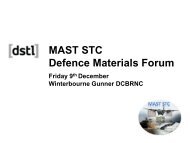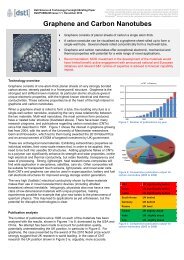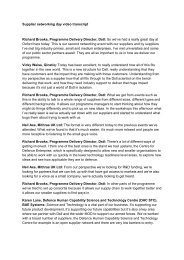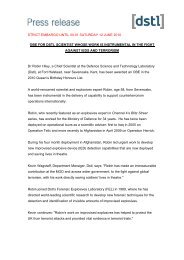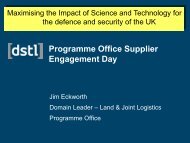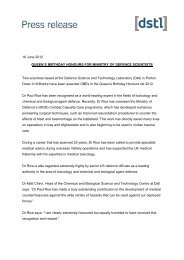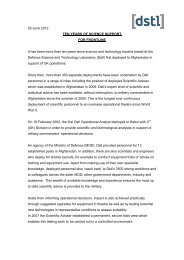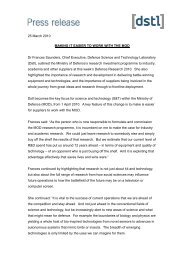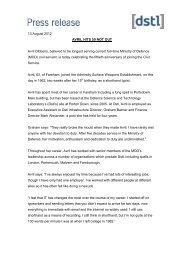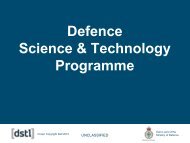Corporate Plan 2013-2018 - Dstl
Corporate Plan 2013-2018 - Dstl
Corporate Plan 2013-2018 - Dstl
You also want an ePaper? Increase the reach of your titles
YUMPU automatically turns print PDFs into web optimized ePapers that Google loves.
The Defence Science and Technology Laboratory<br />
<strong>Corporate</strong> <strong>Plan</strong><br />
<strong>2013</strong> –18<br />
Maximising the impact of science and technology for the defence and security of the UK
Contents<br />
Introduction 04<br />
Our Purpose, Vision and Strategic Objectives 08<br />
Positioning 10<br />
Capability 12<br />
Delivery 16<br />
Critical Enablers 18<br />
Finance 20<br />
Implementation 22<br />
3
Introduction<br />
The Purpose of <strong>Dstl</strong> is to maximise the impact of<br />
science and technology (S&T) for the defence and<br />
security of the UK<br />
“I am pleased to introduce<br />
the <strong>2013</strong>–18 <strong>Corporate</strong><br />
<strong>Plan</strong> for <strong>Dstl</strong>, which<br />
describes our strategy<br />
for delivering against our<br />
Purpose and sets out our<br />
Vision for our continuing<br />
success.”<br />
Jonathan Lyle<br />
<strong>Dstl</strong> Chief Executive<br />
Since our formation in 2001, we have played a critical role in Government<br />
delivering support to the Armed Forces. This has included the planning, development<br />
and employment of the full range of military capability, providing invaluable independent<br />
analysis and advice to the Ministry of Defence (MOD) Equipment Programme while<br />
continuing our commitment to support military operations. Today, thanks to the<br />
expertise and commitment of our staff and our investment in our strategic relationships,<br />
we demonstrate impact across the full breadth of Government defence<br />
priorities and national security challenges. Through Ploughshare Innovations<br />
Limited and the Centre for Defence Enterprise (CDE), we support the Government’s<br />
growth agenda by investing in the development and delivery of new commercial<br />
models that provide funding for innovative new technologies.<br />
Across the defence and security S&T community, we are employing and developing<br />
the capabilities needed to implement the recommendations in the National Security<br />
Strategy (NSS) and the Strategic Defence and Security Review (SDSR) 1 . In doing so,<br />
we are extending our partnerships with industry, academia, wider Government and<br />
our international allies by placing work externally wherever possible. As our<br />
role becomes more consultative, partnering and collaboration will underpin our<br />
success in delivering our role. Collaborative research will add value to all parties, and<br />
facilitate exploration and exploitation to deliver integrated solutions.<br />
This <strong>2013</strong>–18 <strong>Corporate</strong> <strong>Plan</strong> sets out how we will seek to deliver even greater<br />
impact and better value for our customers and the UK economy. We will place an<br />
increasing percentage of the Defence S&T Programme 2 externally with industry and<br />
academia and, while maintaining critical long-term capabilities within Government,<br />
we plan to reduce the size of our workforce by between 15 and 20 per cent over the<br />
next five years.<br />
Our customers and stakeholders tell us that we provide a trusted, safe and<br />
collaborative environment for appropriately managing and safeguarding vital<br />
security and commercial sensitivities. We also support their needs by maintaining,<br />
developing, and exploiting our unique defence and security S&T capabilities<br />
and national assets to provide impact and a vital and necessary service to<br />
Government. While doing this, health and safety is our top priority. We strive to<br />
achieve the highest possible standards in managing safety in our most hazardous<br />
areas and across the organisation.<br />
4<br />
1 H.M. Government, A Strong Britain in an Age of Uncertainty: the National Security Strategy, Cm.7953 (London: TSO,<br />
2010) and H.M. Government, The Strategic Defence and Security Review - Securing Britain in an Age of Uncertainty,<br />
Cm.7948 (London: TSO, 2010)<br />
2 <strong>Dstl</strong> manages and delivers the majority of the Defence S&T Programme owned by the MOD Chief Scientific Adviser (CSA)
Our expert level of scientific<br />
and analytical advice has been<br />
available, without interruption,<br />
to military commanders in<br />
Afghanistan since the summer<br />
of 2005. This is the longest<br />
ever continuous deployment<br />
of scientific personnel to an<br />
overseas operational theatre<br />
since World War II<br />
An exercise involving 190 soldiers<br />
as part of the British Army’s largest<br />
ever virtual battle simulation<br />
(URBAN WARRIOR 5), used our<br />
advanced science and technology<br />
advice and analysis to help the<br />
Army better understand the<br />
battlefield of the future<br />
As Chief Executive, I am proud that we:<br />
• act with integrity as the interface and agent for S&T suppliers to engage with MOD<br />
• have an excellent track record of solving our customers’ problems with diverse and<br />
innovative thinking and delivering timely, relevant and impartial solutions<br />
• are flexible and agile with the ability to respond quickly to new and changing<br />
challenges<br />
• possess a unique breadth and depth of threat knowledge, gathered over decades<br />
• have extensive and diverse networks of the brightest minds, continually expanding our<br />
trusted relationships and reaching out nationally and internationally<br />
• are strategically positioned and play a central role in influencing wider Government<br />
defence and security S&T policy and strategy implementation<br />
• make a difference through our committed and dedicated staff<br />
• have a reputation as one of the most significant Government employers of S&T<br />
professionals and regularly recognised in the Times ‘Top 100 Graduate Employers’, the<br />
Guardian ‘UK 300’ and Job Crowd’s ‘Top 100 Companies to Work For’ polls<br />
• have impact in the UK and overseas beyond our traditional MOD customers<br />
• have demonstrated quality outputs and efficiency over 12 years and have been<br />
awarded the 2012 PricewaterhouseCoopers (PwC) Building Public Trust award for<br />
excellence in reporting in the public sector.<br />
We also recognise areas where we need to make improvements: to integrate<br />
programmes designed and implemented across our portfolio of work; to increase our sharing<br />
of knowledge and best practice across a wider community; to strengthen our procurement<br />
capability, capacity and awareness to meet the growing demand; and to better manage our<br />
relationships with our suppliers.<br />
In developing this year’s <strong>Corporate</strong> <strong>Plan</strong>, we have again considered the wider external<br />
environment and strategic context in which we operate. While the priority risks described in<br />
the 2010 NSS remain as relevant today as when that strategy was published, the character<br />
of each of those risks continues to change. These themes of continuity and change are<br />
relevant to <strong>Dstl</strong>; our overriding Purpose endures but the challenges and opportunities<br />
that we face are changing.<br />
The main contextual challenges we face include: the ongoing efficiencies and streamlining<br />
within MOD, central Government and the wider public sector (Transforming Defence and<br />
the Civil Service Reform <strong>Plan</strong>); how we balance and prioritise against the reduction in<br />
Government spending with subsequent reduced funding from our current customers, while<br />
demand for our services remains strong; the changing nature of the wider National Security<br />
environment (with the planned cessation of combat operations in Afghanistan in 2014);<br />
and the potentially reduced recruitment pool of Science, Technology, Engineering and<br />
Mathematics (STEM) skills in a competitive market for talent.<br />
Since 2011, we have funded<br />
56 PhDs and intend to fund a<br />
further 20 PhDs in <strong>2013</strong>. This<br />
year, we are particularly interested<br />
in Doctoral-level research<br />
programmes on topics to improve<br />
our understanding of human<br />
performance and cognition<br />
5
The first port of call for<br />
defence and securityrelated<br />
S&T within<br />
Government – recognised as<br />
a customer-focused and trusted<br />
agent, demonstrating strong<br />
return on investment<br />
In achieving this we will be<br />
agile and<br />
interdisciplinary<br />
– delivering solutions from the<br />
best sources<br />
Our<br />
Vision<br />
An entrepreneurial<br />
organisation – always<br />
on the front foot, seizing<br />
opportunities<br />
An employer of choice<br />
– a diverse workforce,<br />
recognised for our passion and<br />
commitment to the defence and<br />
security of the UK<br />
6
Over the period of this <strong>Corporate</strong> <strong>Plan</strong>, we will support the successful delivery of the recommendations<br />
in the Government’s White Paper ‘National Security Through Technology’ 3 . We will maximise the return<br />
on investment by working more effectively with others and continue to support the growth agenda by<br />
supporting responsible defence and security exports. We will also continue to provide support to the<br />
implementation of the recommendations from Lord Levene’s Defence Reform Review 4 , for example,<br />
the requirement for Evidence Based Decision Making (EBDM) across Defence and the changing MOD<br />
governance, with a leaner, strategic Head Office setting the direction and the Commands (Front Line<br />
Commands and Joint Forces Command) with delegated responsibility for the Equipment Programme. We<br />
are also helping to clarify the role of S&T in the management of technical risk and the role of the intelligent<br />
customer following the reform of Defence acquisition (Materiel Strategy).<br />
Our Vision for <strong>Dstl</strong> (see diagram opposite) builds on the strategy identified in the previous <strong>Corporate</strong><br />
<strong>Plan</strong> 2012–17 and the opportunities and challenges I have outlined above.<br />
In achieving our Vision, we will:<br />
• be relentless in delivering impact on the highest priority issues, maximising the return on our<br />
customers’ investments and finding new and effective ways of exploiting our unique capabilities<br />
• provide value to the UK taxpayer, exploiting knowledge to build on previous investments, reducing<br />
risk and highlighting our impact whenever possible<br />
• work with others outside of Government to meet defence and security requirements, building on<br />
the already good engagement that we have with S&T communities in the UK and around the world<br />
• embrace both workforce diversity and diversity of thought<br />
• demonstrate and champion transparency as an important component of the Government’s public<br />
service reform agenda<br />
• be entrepreneurial and demonstrate a programme of support for UK economic growth.<br />
To realise our Vision, we believe that we best serve Government by maintaining our Trading Fund status,<br />
driven by our customers and suppliers and guided by their feedback on our products and services.<br />
This model allows us to continue to invest in our unique systems and facilities while ensuring that we<br />
have robust governance mechanisms in place to control our expenditure and report openly against our<br />
business performance. We will continue to be mindful of Ministers’ expectations concerning the future size<br />
and shape of the Civil Service and the role of defence Civil Servants in Government.<br />
The current and future context presents many challenges, not least economic austerity, but there are<br />
plenty of opportunities ahead with customers within MOD, across wider Government and overseas. As we<br />
continue to adapt our organisation at an appropriate pace, striving to do better for less, then we can be<br />
confident about delivering our future success.<br />
Jonathan Lyle<br />
<strong>Dstl</strong> Chief Executive<br />
3 Ministry of Defence, National Security Through Technology: Technology, Equipment, and Support for UK Defence and Security, Cm.8278 (London: TSO, 2012)<br />
4 Ministry of Defence, Defence Reform - An independent report into the structure and management of the Ministry of Defence (London: TSO, 2011)<br />
7
Our Purpose,<br />
Vision and Strategic<br />
Objectives<br />
Our Strategic Framework (see diagram opposite) takes us from where we are today to where<br />
we want to be in <strong>2018</strong>. It sets out what we are here for (our Purpose), what we aspire to<br />
be (our Vision), what we want to achieve (our Strategic Objectives) and how we achieve<br />
them (our Critical Enablers)<br />
Our Purpose is what drives us as an organisation.<br />
We are passionate about it and take pride in how<br />
our personal contributions make a difference to our<br />
customers and the defence and security of the UK.<br />
Our Vision is what we aspire to be as an organisation<br />
over the next five years. Supported by our strategy<br />
for getting there, our Vision builds on the strength of<br />
our heritage, past successes and impact. In line with<br />
Government policy, we will respond appropriately<br />
to external challenges and opportunities, delivering<br />
greater reach and impact with a workforce that has<br />
the right skills and is working in the right locations on<br />
the right problems. Our understanding of our external<br />
environment, matched against our internal strengths<br />
and areas we wish to improve, allows us to make<br />
risk-informed strategic choices.<br />
Derived from our Vision, our Strategic Objectives<br />
in the next sections represent the areas of activity<br />
on which we need to focus if we are to address the<br />
challenges and opportunities posed by the external<br />
environment.<br />
Our Critical Enablers underpin our framework.<br />
These elements are essential for delivering our<br />
Purpose and our Vision effectively, and for achieving<br />
success against our Strategic Objectives.<br />
• An excellent, engaged and agile workforce<br />
• A reputation for integrity and impact<br />
• Access to appropriate facilities and infrastructure<br />
• Safe, resilient and efficient business processes<br />
and systems<br />
• A procurement capability with capacity and<br />
awareness matched to demand<br />
• Productive networks and trusted relationships<br />
• Effective end-to-end delivery of programmes,<br />
portfolios and projects.<br />
8
Strategic Objectives Vision Purpose<br />
To maximise the impact of S&T for the defence and security of the UK<br />
The first port of call for defence and security-related S&T within Government<br />
Agile and interdisciplinary / Entrepreneurial organisation / Employer of choice<br />
Positioning<br />
To be the first port of call for<br />
defence and security-related S&T<br />
within Government, performing a<br />
vital and enduring role<br />
Capability<br />
An agile and interdisciplinary<br />
organisation, aligning our<br />
capabilities with future defence<br />
and security priorities<br />
Delivery<br />
An entrepreneurial<br />
organisation, demonstrating<br />
pull-through and exploitation<br />
of technology and knowledge<br />
to maximise the impact<br />
Critical Enablers<br />
Delivering our Purpose and ensuring we are an employer of choice<br />
9
Positioning<br />
To be the first port of call for defence and security-related S&T within Government,<br />
performing a vital and enduring role<br />
Transforming Defence is the most significant change<br />
programme in a generation and affects everyone in Defence.<br />
A leaner MOD Head Office will be smaller, setting stronger<br />
direction and taking better and more responsible decisions.<br />
The Commands will have delegated programming responsibility<br />
for the Equipment Programme, while Defence Equipment and<br />
Support (DE&S) will be implementing a decision on a potential<br />
change of status after 2014.<br />
Within the new Defence Operating Model, S&T is an important,<br />
strategic enabler and we, as a Trading Fund of MOD, are the<br />
primary MOD S&T agent and enabling organisation. Alongside<br />
the Defence Infrastructure Organisation, Defence Business<br />
Services and DE&S, we are also embracing the use of Strategic<br />
Partners from the private sector to help drive efficiency in<br />
support of the delivery of Defence outputs. These changes will<br />
affect aspects of our existing work and will bring opportunities<br />
to build on our strategic enabler position to increase our impact.<br />
As the Civil Service and MOD landscapes change and, in<br />
line with policy commitments set out in the ‘National Security<br />
Through Technology’ White Paper, we have a prime opportunity<br />
to embed and expand our role as an S&T agent. We are<br />
committed to public service and we understand the implications<br />
for us in fulfilling our core roles for MOD. We are confident<br />
that our performance in supporting defence and security<br />
requirements and the wider Government growth agenda will<br />
provide the evidence for the next quinquennial review of our<br />
Trading Fund status in 2015.<br />
In support of the wider Government growth agenda, we will<br />
seek to develop opportunities to exploit S&T capabilities<br />
to new customers by extending the supplier base for existing<br />
products, services and the delivery of new end-to-end solutions.<br />
We are already engaged in a range of activities that support the<br />
policy for economic growth through:<br />
• Ploughshare Innovations Limited and the commercial<br />
exploitation of our intellectual property<br />
Since our previous <strong>Corporate</strong> <strong>Plan</strong>, we have:<br />
• provided support to customers in MOD Head Office, the Commands<br />
and DE&S by deploying our Science Gateways to work alongside<br />
them while they are reshaping their organisations ensuring S&T is<br />
integral to capability planning, management and delivery<br />
• led collaborative activity in important cross-cutting and novel areas<br />
with other Public Sector Research Establishments (PSREs) such as<br />
the Food and Environment Research Agency supporting Counter-<br />
Improvised Explosive Device research<br />
• implemented a decision-making framework to decide when and how<br />
to support responsible defence and security export opportunities<br />
• implemented a plan to manage our important strategic<br />
relationships with our international partners, industry, academia,<br />
RCUK and have established a memorandum of understanding for<br />
working with the TSB<br />
• completed important enhancements to the CDE model,<br />
expanding its scope to include security, and running the first<br />
‘Marketplace’ to enable SMEs to exploit their technology through<br />
Defence primes.<br />
10
• the Centre for Defence Enterprise (CDE) and supporting<br />
development of novel products and solutions in Small and<br />
Medium-sized Enterprises (SMEs)<br />
• the Defence Suppliers Forum – Research and Development<br />
Group to understand what the support to responsible defence<br />
and security exports and to the growth agenda might mean for us<br />
• the Porton Science Park based at Porton Down offering<br />
state-of-the-art laboratory facilities and specialist support to new<br />
and growing science companies.<br />
The global landscape also continues to move apace, setting out<br />
a complex environment for S&T areas to focus on across our<br />
international relationships. Collaborative research is essential<br />
if MOD and the UK are to maintain a technological advantage.<br />
With finite resources and a large range of external relationships<br />
across <strong>Dstl</strong>, we must focus our strategic relationships on<br />
areas where we will gain maximum benefit as a central hub for<br />
defence and security S&T across Government. Key to this will<br />
be our collaborative working with industry, other Public Sector<br />
organisations, our international partners, academia, the Research<br />
Councils via RCUK and with associated organisations such as<br />
the Technology Strategy Board (TSB). These relationships will<br />
increase our agility, our reach and our resilience.<br />
Over the life of this <strong>Corporate</strong> <strong>Plan</strong> (<strong>2013</strong>–18) the desired<br />
outcomes of this Strategic Objective are in a three-point timeline<br />
below. These outcomes will ensure that we are at the heart<br />
of defence and security, delivering high-impact S&T. We<br />
must stretch ourselves to ensure that we are making the most<br />
of our capabilities to support the Government’s growth agenda<br />
and we must mature our strategic relationships with our priority<br />
international partners, PSREs and our academic and industrial<br />
partners. We believe that if we succeed in our outcomes then<br />
wider Government, our suppliers, and our partners will regard us<br />
as the first port of call for defence and security-related S&T.<br />
During the life of this <strong>Corporate</strong> <strong>Plan</strong>, we will:<br />
THEME START WAYPOINT END<br />
Strategic<br />
Enabler<br />
An important, strategic<br />
enabler in the Defence<br />
Operating Model<br />
providing integrated<br />
support to the<br />
Transforming Defence<br />
Programme<br />
Our vital role understood and<br />
agreed across MOD and a<br />
new DE&S construct<br />
Recognised across Government as the<br />
S&T agent for defence and security<br />
exploiting knowledge, delivering impact<br />
and realising benefits. Supporting<br />
technical risk management and<br />
an intelligent customer across a<br />
transformed MOD<br />
Support to<br />
Growth<br />
Supportive of the wider<br />
Government growth<br />
agenda and working<br />
with PSREs<br />
Priority given to growth<br />
agenda through our wider<br />
support to responsible<br />
exports plus important further<br />
areas identified<br />
Recognised across Government for<br />
maximising impact of S&T on growth<br />
agenda including through Ploughshare<br />
Innovations Ltd, CDE and through<br />
support to defence and security exports<br />
Strategic<br />
Relationships<br />
Priorities for Strategic<br />
Relationships identified<br />
Benefits delivered by<br />
priority actions with the<br />
Research Councils and<br />
international allies<br />
Recognised across Government as the<br />
first port of call for defence and securityrelated<br />
S&T through our network and<br />
integrated approach to S&T delivery<br />
11
Capability<br />
An agile and interdisciplinary organisation, aligning our<br />
capabilities with future defence and security priorities<br />
A vibrant STEM capability 5 is critical to ensuring that our front-line<br />
forces have the best battle-winning technologies for the future.<br />
To meet the needs of defence and security now and into the<br />
future, we need a more integrated approach to our STEM skills<br />
and capabilities, and those owned by our suppliers and partners.<br />
We will reshape our capabilities to retain those areas that must be<br />
undertaken in Government, either for reasons of sensitivity or to<br />
retain an integrating function as an intelligent customer. However,<br />
we will champion wider STEM capabilities (including analytical,<br />
social and behavioural sciences), finding new and innovative ways<br />
to make greater use of industry, academia, wider Government,<br />
and our international partners.<br />
We own many national assets in our facilities and our Helios 6<br />
programme provides an opportunity to collocate some of<br />
these to make better use of our resources. We will improve<br />
our use of facilities across Government, industry, academia and<br />
internationally and fully exploit our existing capabilities by, for<br />
example, encouraging academia to work in our facilities.<br />
We are the leading provider of analysis within Government.<br />
Our core analysis teams will focus on the most important policy,<br />
intelligence, and decision-support work, providing links between<br />
MOD Head Office and the Commands and increasingly across<br />
wider Government. Analytical work supporting equipment<br />
decisions, cost modelling and developing software will be<br />
delivered through growing partnerships with industry.<br />
Since our previous <strong>Corporate</strong> <strong>Plan</strong>, we have:<br />
• improved our understanding of our own STEM<br />
capabilities, how they align to capability in other Government<br />
S&T laboratories and made recommendations to make more<br />
efficient use of resources<br />
• identified critical suppliers of S&T capability against<br />
some of our programmes so that we manage the external<br />
capabilities upon which we rely<br />
• carried out technical benchmarking against external<br />
analysis capabilities and identified actions to focus the<br />
development of our internal capability<br />
• introduced the first Visiting Fellow to <strong>Dstl</strong> and reviewed<br />
options to formalise a scheme to enhance our engagement<br />
with academia<br />
• committed to Knowledge Management (KM) as a strategic<br />
priority and produced an implementation plan<br />
• improved our workforce agility by increasing the ratio of<br />
temporary to permanent civil servants.<br />
5 We define capability as a combination of people (their knowledge, expertise and experience), the enabling infrastructure,<br />
knowledge bases, licences to practice and relationships<br />
6 The relocation of all of our activities from our site in Fort Halstead, Kent, during the next five years<br />
12
We will work with our analytical colleagues from across defence<br />
and wider Government, as well as academics, specialists<br />
in industry and non-traditional sources, to identify new and<br />
innovative approaches applicable to defence and security.<br />
We will also seek to build capability and capacity by engaging<br />
with the private sector on larger clusters of work rather than small<br />
individual tasks.<br />
Our outstanding systems capability will help to ensure that<br />
MOD can sustain capability advantage under open procurement<br />
principles within an affordable defence budget and that we will<br />
be agile and resilient to shocks – prepared to deal with futures for<br />
which we cannot plan. We will develop scientists and engineers<br />
for the nation, returning the investment made in <strong>Dstl</strong> for the<br />
benefit of the Government Science and Engineering community.<br />
We are developing our cyber capability to meet increased<br />
demand and address niche aspects of the wider Government<br />
programme, including situational awareness and cyber defence.<br />
By 2017, we expect to be focusing our internal resources on<br />
operational support, working with technically capable users,<br />
while our partners working within <strong>Dstl</strong> will oversee the technical<br />
development of capability within industry.<br />
We will maintain a world-class capability in Chemical<br />
and Biological defence and security sciences and we<br />
will maximise the exploitation of these capabilities across<br />
Government. There is also scope to deliver work that must be<br />
undertaken in Government more effectively across the PSREs. <br />
During the life of this <strong>Corporate</strong> <strong>Plan</strong>, we will:<br />
THEME START WAYPOINT END<br />
Capability<br />
Management<br />
An excellent understanding of our<br />
internal STEM capabilities<br />
Developing our understanding of<br />
external STEM capabilities and<br />
health, identifying critical external<br />
capabilities<br />
Changes in capacity, competency<br />
and stance of some internal STEM<br />
capabilities completed<br />
Greater transparency through<br />
publication of our Technical<br />
Strategy and recognised as<br />
champions for sharing and<br />
complementing external STEM<br />
capabilities for UK benefit<br />
Recognised as the first<br />
port of call for defence and<br />
security-related S&T through<br />
exploitation of our integrated<br />
view of defence and security<br />
STEM capabilities with a<br />
network of suppliers integrated<br />
into our delivery<br />
Knowledge<br />
Management<br />
Maintain corporate knowledge<br />
base for MOD with strategy for KM<br />
dependent on information systems<br />
recognised as critical to the future<br />
Knowledge capture and new ways<br />
of working in KM piloted in targeted<br />
areas across the defence and<br />
security community<br />
As a trusted agent for S&T, our<br />
KM approaches are exploited<br />
and shared across the widest<br />
possible defence and security<br />
community<br />
Leadership<br />
Leadership recognised as key<br />
to engagement and business<br />
success<br />
Leadership framework and<br />
succession plans implemented<br />
Our leaders build an engaged<br />
workforce ensuring we are an<br />
employer of choice<br />
HoSEP<br />
<strong>Dstl</strong> Chief Executive established<br />
as MOD Head of Science and<br />
Engineering Profession (HoSEP),<br />
Terms of Reference and MOD-wide<br />
action plan agreed<br />
Lead the thinking on careers<br />
for STEM skills in Defence.<br />
Encouraging a more diverse<br />
workforce into defence careers with<br />
clear career routes defined and<br />
communicated<br />
Challenging STEM careers<br />
makes us an employer of<br />
choice – a diverse workforce,<br />
recognised for our passion and<br />
commitment to the defence<br />
and security of the UK<br />
Innovation<br />
Enhancing benefits of innovation<br />
by becoming the focus for defence<br />
and security S&T innovation<br />
Innovation work exploited across<br />
Defence S&T Programme and<br />
beyond<br />
Recognised across<br />
Government as a centre for<br />
defence and security S&T<br />
innovation<br />
13
Capability continued<br />
Our priority in C4ISR 7 and sensors will be to focus<br />
on areas that must be undertaken in Government. We will<br />
maintain technical expertise in information and intelligence<br />
analysis and wider sensing technologies responding to the<br />
increasing demand to support defence intelligence. We will<br />
leverage civilian investments in other aspects of this capability<br />
area such as visual analytics and quantum information<br />
systems.<br />
We are a leading authority on integrated survivability<br />
within Government, providing Systems Engineering solutions<br />
and advice in all operational environments and working<br />
with technical expertise from a wide network of industrial,<br />
international and academic suppliers. Our core teams will<br />
focus on the most sensitive and specialist work that cannot be<br />
undertaken outside Government, for example in the key areas<br />
of signature management, passive and active protection and<br />
balancing across information system options. We will continue<br />
to act as MOD’s technical authority for armour, concentrating<br />
on numerical simulation and modelling.<br />
We will establish and develop our social and behavioural<br />
science hub, accessing the best from outside Government to<br />
work alongside our specialists.<br />
We will lead and develop the creation of a Centre for<br />
Innovation, using Horizon Scanning to identify future trends<br />
and shape Defence S&T Programme requirements. The<br />
Centre will encourage our workforce to seize opportunities to<br />
work with the ‘best of the best’ to solve the biggest future<br />
S&T challenges that face MOD. We will focus on areas such<br />
as advanced manufacturing, advanced materials, precision<br />
navigation and timing. In other areas, such as autonomy and<br />
intelligence, quantum phenomena and synthetic biology,<br />
others will take the lead and we will track developments.<br />
Achieving the right mix of skills in our delivery community will<br />
be a challenging task. The skills and competencies of our<br />
people will need to adapt in line with S&T capability needs<br />
and wider Civil Service STEM initiatives. We are monitoring the<br />
need to maintain Suitably Qualified and Experienced Person<br />
7 Command, Control, Communication and Computers, Intelligence, Surveillance<br />
and Reconnaissance (C4ISR)<br />
14
capabilities in a transformed MOD and any potential increased<br />
demand on us for engineering and wider-applied STEM skills.<br />
We will deploy more staff away from our core sites to<br />
provide integrated advice and reach-back into our organisation.<br />
Skills in technical consultancy and problem-solving will be<br />
essential to work with a broader range of customers and to<br />
exploit the work we do to increase its impact. Our people<br />
will need the analytical and technical skills to provide MOD<br />
with cost reduction and through-life advice and solutions.<br />
These skills will be aimed at getting the most out of what we<br />
have while maintaining in-depth technical expertise in niche<br />
capabilities. We will need to develop skills and mechanisms for<br />
greater openness and contractual skills to do this.<br />
In all that we do, knowledge is our primary output and, as<br />
such, Knowledge Management (KM) is vital. By exploiting<br />
our knowledge, built on previous investments, we can provide<br />
impact by reducing risk in future programmes and provide<br />
value to the UK taxpayer. As our organisation transforms and<br />
we make greater use of external suppliers, implementing the<br />
improvements set out in our KM strategy in terms of people<br />
and technology will be a high priority.<br />
Flexibility, responsiveness and the desire to work beyond<br />
traditional boundaries will be the signature of <strong>Dstl</strong>.<br />
The desired outcomes of this Strategic Objective are in a<br />
three-point timeline on page 13. We will use our unique insight<br />
into the technical challenges for defence and security to drive<br />
decisions regarding the shape and size of our capabilities.<br />
We will publish our Technical Strategy, enabling our partners<br />
and suppliers to engage more strategically with us while we<br />
seek access to the S&T capabilities in those organisations.<br />
We are committed to reducing the size our workforce by<br />
between 15 and 20 per cent over the next five years. Together,<br />
these outcomes will drive us to working in a more agile and<br />
interdisciplinary way, delivering solutions from the best and<br />
most appropriate sources.<br />
15
Delivery<br />
An entrepreneurial organisation, demonstrating pull-through and<br />
exploitation of technology and knowledge to maximise the impact<br />
The defence and security environment is changing. The<br />
upcoming cessation of combat operations in Afghanistan in<br />
2014 and evolving NSS risks will affect S&T priorities as<br />
set out in the ‘National Security Through Technology’<br />
White Paper. Significant change programmes are under<br />
way within MOD (Transforming Defence), public sector and<br />
central Government (Civil Service Reform) aimed at delivering<br />
efficiencies, streamlining and reducing the financial deficit.<br />
The Government has committed to sustain investment in Defence<br />
S&T in a challenging economic environment. Prioritising this<br />
investment and planning, formulating and delivering a<br />
high-impact programme across this changing defence and<br />
security environment, while working alongside the Defence S&T<br />
strategy team, remains a core element of our work.<br />
It is important that we recognise our customers’ needs and the<br />
strategic issues they face. In the light of the change programmes<br />
under way in their organisations, we are changing the way we<br />
interface with our customers. Through the introduction of<br />
Account Managers and their enhanced understanding of our<br />
customers’ needs, we will shape and influence policy, priorities<br />
and our partners to optimise the exploitation and gearing derived<br />
from investment in S&T.<br />
We will broaden the customer base for the capabilities that we<br />
deliver and the services we provide as a trusted S&T agent. We<br />
will develop stronger relationships with our suppliers, working in<br />
open partnership with them, shaping the market and continuing<br />
to place work externally wherever possible.<br />
We recognise that in order to deliver the best value for our<br />
customers we need to improve the way we deliver our work.<br />
We will implement a robust and agile triage process to allow<br />
us to prioritise the work we do. All work will be prioritised<br />
through our account management process and as part of this<br />
simplified delivery process, requirements will be met through<br />
the management of high-impact, coherent programmes,<br />
delivering clearly articulated benefits to our customers and<br />
stakeholders. We continue to achieve these benefits by<br />
Since our previous <strong>Corporate</strong> <strong>Plan</strong>, we have:<br />
• introduced EBDM to the Defence Board as a tool for use when<br />
making decisions<br />
• exploited open architectures into land vehicles and developed a<br />
tool to inform procurement decisions of the potential cost savings.<br />
The tool has also showed the effectiveness of using off-the-shelf<br />
Combat Management System consoles in the Type 26 Global<br />
Combat Ship – which could result in significant savings<br />
• provided key independent airworthiness advice to the<br />
Lightning II Joint Strike Fighter programme, contributing to the<br />
body of evidence required to grant Military Flight Test Permits for<br />
the first two UK aircraft<br />
• established a respected reputation for the delivery of high impact<br />
S&T in support of operations and helped to deliver a safe and<br />
secure Olympics<br />
• communicated the priorities and procurement criteria for<br />
deciding where to source S&T<br />
• delivered, on behalf of the MOD CSA, a Defence S&T Programme<br />
aligned to the ‘National Security Through Technology’ White Paper<br />
with 60 per cent subcontracted to industry and academia.<br />
16
working collaboratively in partnerships across and beyond<br />
Government and we are recognised for our approach within the<br />
public and private sectors.<br />
We will face a diverse range of challenges over the next five<br />
years, many of which we cannot foresee. However, as examples<br />
of significant impact, we plan to:<br />
• provide key evidence to policy makers to support the<br />
decisions for the next SDSR, MOD’s Annual Business Cycle, the<br />
military New Employment Model, the Armed Forces covenant<br />
and the increased use of Reserve Forces<br />
• provide S&T advice to enable the planned drawdown from<br />
combat operations in Afghanistan including logistics planning,<br />
the support for any residual presence and the transition to<br />
contingent operations<br />
• prepare the way for a major collaborative demonstration<br />
programme to develop the next generation of air<br />
combat capability<br />
• build on the Olympics experience and provide technical advice<br />
to support the security and successful operation of major<br />
events (for example the Glasgow 2014 Commonwealth Games)<br />
and provide expertise to wider Government<br />
• in support of the International Defence Engagement<br />
Strategy and International Research Collaboration we will<br />
work with policy setters to achieve maximum value from S&T.<br />
The desired outcomes of this Strategic Objective are in a<br />
three-point timeline below. We will be proactive and more<br />
entrepreneurial. We will continually look for opportunities to<br />
maximise the impact of S&T across a broader range of customers<br />
on a wider range of S&T challenges with the best sourced<br />
solutions. Our priorities will be to support current and contingent<br />
defence and security operations, to benefit economic austerity<br />
and prosperity through cost reductions for Government, and to<br />
support Intellectual Property generation and responsible exports.<br />
We will be better at prioritising our work through the strategic<br />
triaging of opportunities informed by a data-driven sales plan.<br />
During the life of this <strong>Corporate</strong> <strong>Plan</strong>, we will:<br />
THEME START WAYPOINT END<br />
Customer<br />
Engagement<br />
Strong reputation with customers<br />
for impact and delivery. Lessons<br />
identified from pilots in managing<br />
successful programmes<br />
and operating an account<br />
management process<br />
Reputation with customers<br />
maintained as we implement<br />
change programme in line with<br />
Transforming Defence and wider<br />
Government policy to further<br />
improve customer experience<br />
Excellent reputation as the<br />
first port of call for defence<br />
and security-related S&T for<br />
delivering impact and adding<br />
value with a wider range of<br />
customers across Government<br />
Supplier<br />
Engagement<br />
Immature supplier management<br />
capability with suppliers unaware<br />
of all future opportunities<br />
Key Supplier Management for Top<br />
20 suppliers<br />
Timely access to required<br />
external capability.<br />
Recognised as trusted agent<br />
for S&T by suppliers<br />
Programme<br />
Formulation<br />
Realigning projects at programme<br />
level to leverage across Defence<br />
S&T Programme and beyond<br />
Improved programme management<br />
and rapid triage against priorities<br />
Opportunities seized routinely<br />
with delivery focused around<br />
cost effective programme<br />
outcomes and benefits<br />
Delivery in<br />
Partnership<br />
Some programmes delivered<br />
collaboratively, especially with<br />
international partners<br />
Stronger relationships with national<br />
partners<br />
Majority of programmes<br />
delivered jointly in collaboration<br />
with industrial, national and<br />
international partners<br />
Technology<br />
Advice and<br />
Services<br />
Our national assets and unique<br />
technical services maintained,<br />
funded and delivered successfully<br />
through separate service models<br />
Advice and services embedded in<br />
capability delivered programmes<br />
with utilisation managed<br />
Advice and services delivered<br />
co-operatively, efficiently and at<br />
high utilisation<br />
17
Critical Enablers<br />
Delivering our Purpose and ensuring we are an employer of choice<br />
We believe in the vital role of public servants in undertaking<br />
the work we deliver in direct support of our customers in<br />
MOD, across wider Government and with trusted international<br />
partners. Central to this is an excellent, engaged and agile<br />
workforce that is the right shape and size, working in the right<br />
locations and answering the right problems. Since 2001, our<br />
status as a Trading Fund of MOD has given us the ability to<br />
do that effectively and efficiently, maintaining a strong profile<br />
within the defence and security community with a reputation<br />
for integrity and impact. These Critical Enablers set out the<br />
elements of the business that are essential to delivering our<br />
Purpose effectively, without which our likelihood of achieving our<br />
Strategic Objectives would reduce significantly.<br />
The continued planning for our Helios programme and the<br />
current economic climate mean that we need to drive for<br />
efficient solutions while ensuring access to appropriate<br />
facilities and infrastructure. We will continue to look for every<br />
opportunity to do things more efficiently with the capabilities<br />
provided by our Strategic Partners, Steria and Serco.<br />
To improve both our own use of information as well as<br />
its exploitation in wider Government, we will continue to<br />
ensure the safe, resilient and efficient operation of our<br />
business processes and systems. We will also address the<br />
opportunities afforded within Civil Service Reform including<br />
the new Government ‘Digital by Default’ strategy. To support<br />
our Vision we will implement a procurement capability with<br />
capacity and awareness matched to demand, seeking<br />
to improve our management of suppliers and update our<br />
procurement strategy to align with our evolved role as MOD’s<br />
S&T agent.<br />
Since our previous <strong>Corporate</strong> <strong>Plan</strong>, we have:<br />
• maintained sound financial management to allow us to initiate<br />
our Helios programme, funded from our own capital investment<br />
programme<br />
• been awarded the 2012 PwC Building Public Trust award for<br />
excellence in reporting in the public sector<br />
• realigned our Infrastructure Portfolio Management Office to<br />
provide oversight of a balanced and prioritised portfolio of<br />
infrastructure-based projects<br />
• optimised our assurance framework around our important<br />
strategic risks and transformed our approach to internal control,<br />
operation and assurance<br />
• worked with our strategic service partners to improve efficiency<br />
and asset utilisation<br />
• realigned our Safety, Health, Environment and Fire (SHEF)<br />
internal support and conducted a workforce survey to baseline<br />
and improve our organisational SHEF culture and better enable us<br />
to operate safely<br />
• successfully completed safety audits of the majority of our<br />
hazard areas with corrective action in place where required.<br />
18
Our productive networks and trusted relationships enhance<br />
the value of our investment in S&T and provide advantage with<br />
our national and international partners.<br />
Our effective end-to-end delivery of programmes,<br />
portfolios and projects will enable us to deliver a high-impact<br />
S&T programme across a changing defence and security<br />
environment.<br />
The desired outcomes of these Critical Enablers are in a<br />
three-point timeline below. Our people are our most valued<br />
asset and we are committed to investing in their leadership<br />
development and their technical and professional skills, ensuring<br />
we become an employer of choice. We are committed to<br />
maximising the diversity of our workforce and giving our<br />
talented people the best chance of career progression and<br />
personal development in a safe and secure environment. As<br />
an effective and efficient organisation, continually seeking<br />
improvement, we will complete our Helios programme and<br />
markedly improve our commercial and information systems.<br />
These activities will enable us to work successfully and share<br />
knowledge in a much more effective way than today.<br />
Achieving these outcomes is critical to our agility, our ability to<br />
seize opportunities and to enable our passionate and committed<br />
workforce, suppliers and partners, to maximise the impact of S&T.<br />
During the life of this <strong>Corporate</strong> <strong>Plan</strong>, we will:<br />
THEME START WAYPOINT END<br />
Effective<br />
and Efficient<br />
Organisation<br />
Helios programme initiated with<br />
associated staff relocation<br />
under way<br />
Helios build programme<br />
commenced, core capabilities<br />
and all staff transitioned from Fort<br />
Halstead site<br />
Effective, efficient and integrated<br />
organisation operating from our<br />
reduced core sites<br />
Procurement<br />
Capability<br />
Commercial capacity adequate to<br />
meet overall demands of current<br />
work but improvements needed to<br />
realise our Vision<br />
Procurement strategy<br />
implemented, contracting<br />
consolidated and commercial<br />
awareness of all staff improved<br />
The first port of call for defence and<br />
security-related S&T and trusted<br />
S&T agent status underpinned by<br />
procurement capability, capacity and<br />
awareness that is matched to demand<br />
with supply chain interface managed<br />
Information<br />
Systems<br />
Information systems adequate<br />
for our current requirement but<br />
investment and innovation required<br />
to realise our Vision<br />
Key investments supported<br />
with prioritisation of information<br />
systems to support knowledge<br />
management and exploitation<br />
Information systems enabled that support<br />
our ability to be an entrepreneurial<br />
organisation and seize new opportunities,<br />
be transparent and share knowledge as a<br />
trusted agent of S&T<br />
SHEF and<br />
Resilience<br />
Safe, secure and resilient<br />
organisation actively reviewing<br />
baseline policy and processes and<br />
setting targets to address changing<br />
Government needs<br />
Implementation of new safety<br />
culture targets completed and a<br />
proactive, risk-informed approach<br />
to all our site operations<br />
A learning organisation that proactively<br />
addresses safety, environmental and<br />
resilience issues<br />
Civil Service<br />
Reform<br />
Implementation of changes driven<br />
by Civil Service Reform commenced<br />
with further work under way to<br />
access impact<br />
Revisions to services agreed and<br />
our processes improved in line with<br />
our Vision and Civil Service Reform<br />
An integrated organisation taking and<br />
offering services to the Civil Service<br />
with the infrastructure that supports<br />
integrated working<br />
Strategic<br />
Partners<br />
Strategy developed to optimise<br />
relationship with Serco and Steria<br />
with new performance indicators to<br />
emphasis partnership and shared<br />
responsibility<br />
Strategic Partners proactively<br />
shape planning with us to provide<br />
timely enabling services efficiently<br />
Strategic Partners operating in an<br />
integrated organisation as part of our<br />
delivery enabling our Vision<br />
Regulation<br />
Maintain regulatory compliance<br />
while continually seeking areas for<br />
improvement<br />
Reduce any residual risks<br />
associated with maintaining<br />
compliance<br />
Recognised across Government<br />
for pro-activity and best practice in<br />
regulatory compliance<br />
19
Finance<br />
Our principal financial objectives are to meet our obligations<br />
to MOD and to self-fund our investment programme<br />
All figures in (£) million Forecast <strong>Plan</strong><br />
<strong>2013</strong> 2014 2015 2016 2017 <strong>2018</strong><br />
Total sales 621 637 597 582 583 582<br />
Operating profit 28 27 24 16 18 24<br />
Capital investment 16 45 43 29 22 26<br />
End of year cash balance 104 81 58 45 41 44<br />
All figures are presented in real terms at <strong>2013</strong>/14 monetary values and no inflation is built into future years<br />
We are obligated to pay dividends and<br />
interest to MOD that, taken together,<br />
represent a 3.5 per cent Return on Capital<br />
Employed (ROCE). These objectives will be<br />
achieved by sustaining adequate levels of<br />
profitability and cash flow.<br />
Future cash flows are ahead of last year’s<br />
plan in the short term and in line with<br />
previous projections from 2017 onwards<br />
after completion of the relocation from our<br />
Fort Halstead site (Helios programme). The<br />
cumulative profit and cash performance<br />
remains sufficient to fund the necessary<br />
capital investment to deliver Helios.<br />
Declining profits up to 2017 are a reflection<br />
of income reducing faster than <strong>Dstl</strong> can<br />
reduce its fixed cost base. The full financial<br />
benefits of site rationalisation under Helios<br />
are realised from <strong>2018</strong> onwards.<br />
Sales<br />
We derive sales revenue from work<br />
subcontracted to third parties, from work<br />
carried out by our staff and from the<br />
use of our specialist facilities. Demand<br />
has remained high despite the budget<br />
pressures on our customers, mainly those<br />
from MOD and wider Government.<br />
Sales projections are a best estimate<br />
based on the information available at the<br />
time of writing this <strong>Corporate</strong> <strong>Plan</strong>. Due<br />
to the Transforming Defence programme,<br />
there remains a high degree of uncertainty<br />
and volatility in MOD. Our agility as a<br />
Trading Fund means that variations in<br />
sales are matched by corresponding<br />
variations in costs, with a much smaller net<br />
impact on profit and cash.<br />
- Defence S&T Programme<br />
The Defence S&T Programme will continue<br />
to be a very significant element of our<br />
work and the overall Programme budget<br />
will decline further in Year 1 of this plan.<br />
Our intention to increase the proportion<br />
of the Defence S&T Programme that is<br />
subcontracted through the private sector<br />
and academia causes an additional<br />
reduction in our net income.<br />
- Support to Current Operations<br />
Sales will decline further because of<br />
reduced support to current military<br />
operations in Afghanistan over the next<br />
two years, coupled with cessation of direct<br />
supplementary funding from HM Treasury.<br />
The Defence S&T Programme will fund<br />
future support to contingency planning.<br />
- Defence Equipment & Support (DE&S)<br />
Further uncertainties are caused by<br />
changes under MOD’s Transforming<br />
Defence programme, with the future of<br />
DE&S still under review. While there are<br />
short-term opportunities arising from<br />
acquisition reform, our longer-term support<br />
to the Equipment Programme is expected<br />
to decline over the period of this plan.<br />
- Wider Government<br />
Aggregated demand from wider<br />
Government and non-Exchequer sources<br />
is expected to sustain but UK public<br />
sector budgets remain under pressure and<br />
security-related expenditure may no longer<br />
be prioritised. While we have seen an<br />
increasing demand for some capabilities,<br />
such as EBDM, the focus will be on<br />
working with others and burden-sharing to<br />
achieve greater value for money.<br />
Our staff charge rates have not been<br />
increased in cash terms since 1 April<br />
2009. Through the life of this plan, we<br />
intend to increase our staff charge rates in<br />
line with inflation 8 . The fee (profit margin)<br />
on our ascertained cost work remains at<br />
3 per cent and no further changes in fee<br />
rate structure are currently planned.<br />
Operating costs<br />
Our operating costs are expected to<br />
decline as the volume of internally<br />
delivered work falls. Two thirds of our<br />
operating costs relate to staff, and we<br />
plan for the average total workforce to<br />
reduce by between 15 and 20 per cent<br />
over the next five years. Civil Service<br />
recruitment controls and pay restraints<br />
remain in place in the short to medium<br />
term. Our continued use of contractors<br />
and fixed-term appointments will give us<br />
the opportunity to flex the total workforce<br />
in line with varying demand, without<br />
8 As measured by the HM Treasury Gross Domestic Product (GDP) Deflator index<br />
20
Capital Investment Profile <strong>2013</strong>–18<br />
Closing cash balance over the next nine years<br />
(£) million<br />
50<br />
40<br />
30<br />
(£) million<br />
120<br />
100<br />
80<br />
20<br />
10<br />
60<br />
40<br />
20<br />
0<br />
<strong>2013</strong> 2014 2015 2016 2017 <strong>2018</strong><br />
0<br />
2011 2012 <strong>2013</strong> 2014 2015 2016 2017 <strong>2018</strong> 2019 2020 2021 2022<br />
Total planned capital expenditure over the next five years<br />
Last year’s plan<br />
Base Case<br />
increasing the underlying permanent<br />
headcount.<br />
We continue to review the value of all our<br />
operating expenditure. The Helios site<br />
rationalisation programme is expected to<br />
deliver annual cost reductions of<br />
£12 million from <strong>2018</strong> onwards, with<br />
some early savings realised in 2017 as<br />
vacation of our Fort Halstead site occurs.<br />
The consolidation from three to two core<br />
sites is a major contributor to our future<br />
operational efficiency.<br />
The majority of our non-staff operating<br />
costs are sourced through our principal<br />
service contracts (Steria and Serco)<br />
for information systems and facilities<br />
management support. These are under<br />
continuing review to ensure they provide<br />
the required mix of services at a price that<br />
represents good value. Depreciation is<br />
expected to rise from £13 million in <strong>2013</strong><br />
to more than £20 million by <strong>2018</strong> due to<br />
planned capital investment.<br />
Capital investment<br />
Total planned capital expenditure until<br />
<strong>2018</strong> is £165 million, of which £51 million<br />
is directly attributable to the Helios<br />
programme. The final costed designs for<br />
new facilities under Helios are expected<br />
in autumn <strong>2013</strong> with construction starting<br />
in early 2014. Early staff relocations have<br />
already commenced and we are using<br />
flexible desk-sharing arrangements to<br />
ensure the relocated workforce can be<br />
accommodated within existing working<br />
environments.<br />
£38 million of our planned capital<br />
expenditure relates to important enabling<br />
projects at our Porton Down site. The<br />
scope of these planned investments<br />
(which pre-date Helios) has been updated<br />
to ensure the existing infrastructure<br />
is scaled up where necessary to<br />
accommodate increased staff numbers on<br />
site and that it meets the requirements of<br />
specialist facilities transferring from<br />
Fort Halstead.<br />
Of the remaining £76 million, we continue<br />
to focus our investment priorities on:<br />
• development of our business systems<br />
and telecommunications technology to<br />
underpin improved ways of working and<br />
process efficiency<br />
• maintenance and replacement of important<br />
technical facilities where we are a provider<br />
of a nationally critical or niche capability<br />
• infrastructure to sustain regulatory<br />
compliance and our ‘licence to operate’<br />
in certain fields, and to reduce energy<br />
consumption<br />
• development of new capabilities to deliver<br />
the business of the future.<br />
Funding and cash flow<br />
We continue to be partially funded by a<br />
£32 million loan from MOD, which is being<br />
repaid over 10 years up to 2020. No<br />
additional funding is assumed over the life<br />
of this plan. Our planned interest, dividend<br />
and loan repayments to MOD amount to an<br />
average of more than £14 million per year,<br />
totalling £72 million over the plan period.<br />
Profitability and the level of capital investment<br />
principally drive cash flow, with working<br />
capital fluctuations being neutral over time.<br />
The sustained high level of investment<br />
associated with the Helios programme over<br />
the next four years, coupled with falling<br />
profitability as net income falls, causes a<br />
decline in our cash balances.<br />
Our financial viability has been tested by<br />
ensuring that our cash balance remains<br />
positive despite a further potential downturn<br />
in revenue coupled with a more costly<br />
investment programme. As described in<br />
our Strategic Objectives, there are also<br />
opportunities that could result in improved<br />
trading performance if we undertake additional<br />
activity consistent with our Purpose.<br />
Once the cost savings from site<br />
rationalisation are fully realised, our cash<br />
balance recovers rapidly and gives us the<br />
opportunity to undertake further investment<br />
or share the benefits of a reduced cost base<br />
with our customers and MOD.<br />
21
Implementation<br />
At the heart of our strategy planning is strategic risk management,<br />
helping to make well-informed choices. The <strong>Dstl</strong> Business <strong>Plan</strong><br />
<strong>2013</strong>/14 will support the aims of this <strong>Corporate</strong> <strong>Plan</strong>, setting<br />
out how we intend to deliver and measure our progress<br />
Strategic Objectives<br />
Positioning<br />
To be the first port of call for<br />
defence and security-related S&T<br />
within Government, performing a<br />
vital and enduring role<br />
Capability<br />
An agile and interdisciplinary<br />
organisation, aligning our<br />
capabilities with future defence<br />
and security priorities<br />
Delivery<br />
An entrepreneurial organisation,<br />
demonstrating pull-through and<br />
exploitation of technology and<br />
knowledge to maximise the impact<br />
Critical Enablers<br />
Delivering our Purpose and ensuring we are an employer of choice<br />
Implementation <strong>Plan</strong>s<br />
Our Chief Executive holds our Directors to account for<br />
delivery of both the transactional daily business and<br />
the transformational change activities through a set of<br />
Implementation <strong>Plan</strong>s. These plans will form the heart of<br />
our Business <strong>Plan</strong> for the first year of this <strong>Corporate</strong> <strong>Plan</strong>.<br />
Good governance will require clear and delegated authority<br />
with responsibility given to those being held accountable.<br />
Our Directors will require the support of their senior<br />
management teams to deliver our strategy throughout<br />
the organisation. This governance will give them the<br />
necessary authority and responsibility to deliver in the best<br />
way possible.<br />
We maintain a <strong>Corporate</strong> Risk Register containing all risks<br />
of a strategic nature with clear ownership by our Executive.<br />
The principal risks to the successful delivery of this plan are:<br />
• lack of organisational agility means we cannot<br />
respond effectively to key priorities and events with<br />
sufficient pace<br />
• insufficient knowledge of the wider capability base<br />
we can access now, and in the future, leads to<br />
incorrect divestment and investment decisions<br />
• insufficient investment in our knowledge and<br />
information management capability (including<br />
behaviours, communications, systems and<br />
processes) prevents access to and exploitation of<br />
our broader network<br />
• failure to complete and deliver the benefits of our<br />
Helios programme prevents the effective, efficient<br />
and integrated operation from our reduced<br />
core sites.<br />
22
T +44 (0) 1980 613121<br />
F +44 (0) 1980 613004<br />
E centralenquiries@dstl.gov.uk<br />
For more information about <strong>Dstl</strong>’s work, visit<br />
www.dstl.gov.uk<br />
© Crown copyright <strong>Dstl</strong> <strong>2013</strong><br />
<strong>Dstl</strong>/DOC71428



